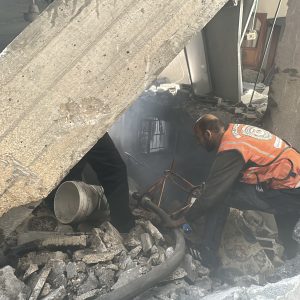Women forced to flee northern Gaza share harrowing stories
Gaza City, Palestine (AA) – Palestinian women displaced by the Israeli army’s attacks on northern Gaza since October 6 have shared their harrowing experiences with journalists.
Malak Elyan and Aya Al-Tanani arrived in Gaza City from Beit Lahiya, visibly exhausted from the bombardments, hunger, and the toll of forced migration.
They recounted a challenging journey under the constant threat of Israeli military action, describing how thousands of people were gathered in areas surrounded by military vehicles.
The women reported that the army detained the men and allowed women to leave via designated routes.
The army began yet another ground assault in northern Gaza on October 6, following intense airstrikes, particularly targeting the Jabalia refugee camp on October 5.
This action is believed to align with a “generals’ plan” aimed at preparing settlements for Israelis by forcibly evacuating Palestinians from northern Gaza.
Israeli army spokesperson Avichay Adraee warned Palestinians in Beit Hanoon, Jabalia, and Beit Lahiya on October 7, providing a map of areas designated for evacuation.
Adraee urged Palestinians to move to the al-Mawasi region in southern Gaza. The map he shared bore striking similarities to the “generals’ plan” proposed by former Operations Division Chief General Giora Eiland, which called for the forcible relocation of Palestinians and was submitted to the government.
While Tel Aviv has not officially commented on the reported plan, Israeli state broadcaster KAN indicated that the Cabinet reviewed it in September.
– ‘We know nothing about them’ –
Elyan, in her 20s, sustained injuries during an Israeli attack on October 10, which left her with a dislocated shoulder that required a titanium prosthesis.
In addition to her injuries, Elyan said she lost both her son and her brother in the Israeli attacks.
Speaking about her forced migration, Elyan explained that the army sent drones to the area where they were staying, instructing them to head toward the Indonesian Hospital.
She expressed shock at seeing military vehicles and drones as she followed the path determined by the army with the remaining members of her family.
Elyan noted that the army detained Palestinians who were urged to evacuate to a school, separating men and women into different schools.
Speaking about the detained Palestinian men, Elyan said, “We know nothing about them.”
She also mentioned the panic and chaos experienced during the displacement, with children losing their mothers. Elyan voiced concern for her father, who was detained at Kuwait School.
– Israeli bombardment and forced migration –
Al-Tanani, 16, described the difficulty in reaching family members who had been detained.
She endured intense bombardments for 18 days under the Israeli siege before being forced to flee Beit Lahiya. “We heard a child scream, ‘My mom’s pulse is racing, come save her,’ after a nearby house was bombed,” said Al-Tanani.
Despite the urgency to help, she noted that bodies remained unclaimed in the area.
Al-Tanani described the atmosphere of fear and chaos, which pressured residents to follow the path set by the Israeli army.
After following the designated route, Al-Tanani and Elyan arrived at two schools, where the army separated men and women.
“When we reached the two schools, we were astonished and horrified. The fact that they were filled with thousands of people and no one knew their fate was terrifying,” she said.
Al-Tanani added that military vehicles were placed next to the schools, coercing residents into following one specific path. She mentioned that soldiers wrapped the heads of detained Palestinian men with white cloth and handcuffed them.
Al-Tanani said that many displaced people believed the men’s treatment by the army could be a prelude to “field executions.”
She also expressed her desire for the genocidal onslaught to end, stating that she hopes to complete her education.
Despite a UN Security Council resolution calling for an immediate cease-fire, the Israeli army has continued its devastating offensive on Gaza following the Hamas attack on October 7, 2023.
More than 42,700 people, mostly women and children, have been killed, and over 100,300 injured, according to local health authorities.
The Israeli onslaught has displaced nearly the entire population of Gaza, amid a blockade that has caused severe shortages of food, clean water, and medicine.
Israel now faces a genocide case at the International Court of Justice for its actions in Gaza.











